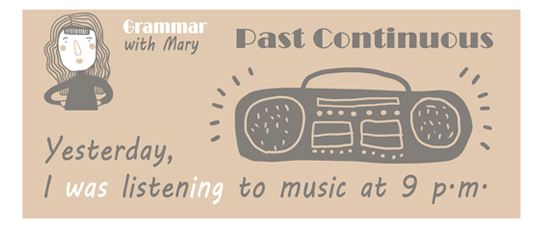Hi, this is me again, and I hope you had a great day.
You know, yesterday I was listening to music at 9 p.m.
What were you doing at that moment?
So, tell me please, what tense is that?
This tense is called the past continuous tense.
We use it to talk about an action that was IN PROGRESS at a certain time in the past.
For example, “yesterday at 9” is a certain time in the past.
What was I doing? I was listening to music.
What were you doing five minutes ago?
Are you still doing it?
And while I was listening to music, I was also cooking dinner.
I was listening and cooking at the same time. Two actions were happening at the same time in the past, and they were both continued actions. We use the past continuous tense to show that two actions were happening at the same time in the past. The subjects of the action can be different. I can say that while I was listening to music, my mother was talking on the phone.
So tell me please, what were you doing while you were getting to work yesterday?
Suddenly, while I was listening to music, my computer stopped working.
So I was in the process of a continued action (listening to music) which was interrupted by a single action (my computer stopped working). We use the past continuous for the continued action and the past simple tense for the short (interrupting) action.
What happened while you were getting to work?
Who called you while you were working?
How do we form the past continuous tense? This is very easy.
For the affirmative form we use the subject plus was/were and the verb with –ing ending.
I was cooking. We were listening. He was talking.
Please make the affirmative past continuous form of the verb “to laugh” with the subject “she”.
Correct! She was laughing.
Now let's make the past continuous affirmative form of the verb “to kiss” of the subject “they”.
Good job! They were kissing.
In order to make the negative form, we just add “not” to the was/were, which makes them was not (wasn't) or were not (weren't) and add the Verb-ing. He wasn't thinking, they were not walking.
- The dog – to run. Please make the negative past continuous form! Correct! The dog was not running.
- Now do the same with “we” and “to look”. We weren't looking.
How do we make questions?
This is quite easy. Question word, then was/were, then subject, and then verb-ing.
What were you talking about?
Why was he kissing her?
We can ask a yes/no question. We don't necessarily have to use a question word. Was he listening? Were they talking?
Please make the questions for these answers.
1. No, she wasn't writing to him.
2. They were eating a salad.
Are you ready? Let's check!
1. Was she writing to him?
2. What were they eating?
We don't have to answer with a full sentence, we can say “No, she wasn't” or “Yes, we were”.This is called a short answer. We form a positive short answer with Yes, the subject and was/were. We form a negative short answer with No, the subject and wasn't/weren't.
I hope that you were listening while I was explaining!
See you soon!
















